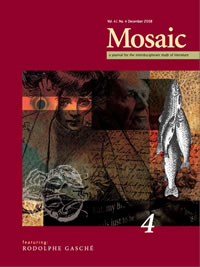Issue 41.4
Overview

General Issue
Published: December 2008
View the issue introduction or see the issue summary and contents below.
10 essays, totalling 192 pages
$19.95 CAD
The first in Mosaic’s “feature author” series, this issue, featuring Rodolphe Gasché, opens with a Gasché interview and two essays by him—on Walter Benjamin’s theory of film and on the “harmless detail” in Hegel’s Aesthetics. The issue includes an additional seven essays on the topics of: female memory and the allegory of gender; narrative ethics and incommensurable discourses; women’s loss and literary representation; fetal imaging; literary contributions to the animal question; white tomboyism and American Indian tribalism; and the Bhadramahila and adaptation.
Crossings: An Interview with Rodolphe GaschéDawne McCance This conversation with Rodolphe Gasché—a keynote speaker at Mosaic’s 2006 conference, Following Derrida: Legacies—evolved over several months. Mosaic is pleased to publish the interview here. | |
The Deepening of Apperception: On Walter Benjamin’s Theory of FilmRodolphe Gasché According to Walter Benjamin, the history of photography is a process of progressive emancipation of reproductive technology from magic and the aura. This process culminates in the art of cinema as a public art in which total transparency is achieved. The essay attempts to investigate the changes in perception that come with the new technologies and the progressive evacuation of the sacred and the auratic from art. | |
The Harmless Detail: On Hegel’s AestheticsRodolphe Gasché Although "detail" is not a technical concept, it is, according to Hegel, intimately linked to the sphere of the fine arts, in particular classical art, where it is a determined modality of particularization. Focusing on Hegel's analysis of Greek and contemporary statuary, the essay shows how detail is linked to the measurement of the human figure, in particular to the size of its feet. | |
Modern Mnemosynes: Female Memory and the Allegory of GenderJohn Lurz This essay examines the peculiar alignment of memory and femininity in three modern writers. Placing Henry James’s “The Beast in the Jungle” in dialogue with the figure of Mnemosyne instanced in Heidegger and Derrida, it suggests that this gendered figuration leads ultimately into the fundamentally and inescapably allegorical nature of memory itself. | |
Narrative Ethics and Incommensurable Discourses: Lyotard's The Differend and Fowles’s The CollectorAmit Marcus The essay highlights the contribution of Lyotard's conceptions of incommensurable discourses, damage, and wrong in his work Le Differend to the ongoing disputes between neo-humanists and Levinasians in literary studies. I interpret John Fowles’s The Collector in light of Lyotard's thesis, and demonstrate how this thesis is illuminated by Fowles’s novel. | |
Generative Melancholy: Women’s Loss and Literary RepresentationVictoria L. Smith Using the psychoanalytic concept of melancholia, this essay develops a feminist analysis of the concept of loss and posits a relationship among women’s subjectivity, loss, and literary representation. In recognizing loss and in representing it, certain women’s modern and postmodern novels utilize a strategy of resistance—stagings of loss—to effect compensation. | |
(Re)presenting the Fetus: The Limits of Objective Vision in “Birthmates” and “The Ultrasound”Angela Laflen Although fetal images are common in contemporary culture, they still pose interpretive difficulties, which are highlighted in Gish Jen’s “Birthmates” and Chitra Banerjee Divakaruni’s “The Ultrasound.” This essay argues that these authors undercut discourses claiming to objectively interpret fetal images by foregrounding conflicts of interpretation and the embodied nature of vision. | |
Queneau’s Poissons and Guimarães Rosa’s Jaguar: Two Literary Contributions on the Animal and Human ConditionsÉlide Valarini Oliver Working through two texts by Queneau and Guimarães Rosa, this essay outlines several attitudes towards animals that have become paradigmatic in Western cultures. Following Guimarães Rosa, the essay offers a comparative perspective on how to rethink “animal thinking.” | |
Becoming a “Red-Blooded” American: White Tomboyism and American Indian Tribalism in Caddie WoodlawnMichelle Ann Abate This essay unpacks the way in which white tomboyism and American Indian tribalism mutually construct each other in Caddie Woodlawn. Caddie’s ability to cross the gender line facilitates an ability to cross the racial one and be classified as a non-white “wild Indian,” an act that has implications for her national identity. | |
The Bhadramahila and Adaptation in Meera Syal’s and Gurinder Chadha’s Bhaji on the BeachDanette DiMarco and J. Sunita Peacock Bhaji on the Beach critiques the bhadramahila or “respectable woman” construct that took root in nineteenth-century pre-independence, colonial Bengal and that still impacts Indian females living abroad. This essay examines bhadramahila discourse through intertextual and postcolonial lenses and reveals modern disconnects with the historical construct. |